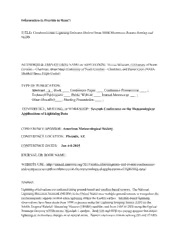
NASA Technical Reports Server (NTRS) 20150002882: Cloud-to-Ground Lightning Estimates Derived from SSMI Microwave Remote Sensing and NLDN PDF
Preview NASA Technical Reports Server (NTRS) 20150002882: Cloud-to-Ground Lightning Estimates Derived from SSMI Microwave Remote Sensing and NLDN
Information to Provide to Rene’: TITLE: Cloud-to-Ground Lightning Estimates Derived From SSMI Microwave Remote Sensing and NLDN AUTHOR(S) & EMPLOYER(S) NAME or AFFLIATION: Thomas Winesett, (University of North Carolina – Charlotte), Brian Magi (University of North Carolina – Charlotte), and Daniel Cecil (NASA Marshall Space Flight Center) TYPE OF PUBLICATION: Abstract x Book Conference Paper Conference Presentation ; Technical Publication Public Website Journal Manuscript _ ; Other (describe)____; Meeting Presentation ; CONFERENCE, MEETING, or WORKSHOP: Seventh Conference on the Meteorological Applications of Lightning Data CONFERENCE SPONSOR: American Meteorological Society CONFERENCE LOCATION: Phoenix, AZ CONFERENCE DATES: Jan 4-8 2015 JOURNAL OR BOOK NAME: WEBSITE URL: http://annual.ametsoc.org/2015/index.cfm/programs-and-events/conferences- and-symposia/seventh-conference-on-the-meteorological-applications-of-lightning-data/ Abstract: Lightning observations are collected using ground-based and satellite-based sensors. The National Lightning Detection Network (NLDN) in the United States uses multiple ground sensors to triangulate the electromagnetic signals created when lightning strikes the Earth's surface. Satellite-based lightning observations have been made from 1998 to present using the Lightning Imaging Sensor (LIS) on the NASA Tropical Rainfall Measuring Mission (TRMM) satellite, and from 1995 to 2000 using the Optical Transient Detector (OTD) on the Microlab-1 satellite. Both LIS and OTD are staring imagers that detect lightning as momentary changes in an optical scene. Passive microwave remote sensing (85 and 37 GHz brightness temperatures) from the TRMM Microwave Imager (TMI) has also been used to quantify characteristics of thunderstorms related to lightning. Each lightning detection system has fundamental limitations. TRMM satellite coverage is limited to the tropics and subtropics between 38°N and 38°S, so lightning at the higher latitudes of the northern and southern hemispheres is not observed. The detection efficiency of NLDN sensors exceeds 95%, but the sensors are only located in the USA. Even if data from other ground-based lightning sensors (World Wide Lightning Location Network, the European Cooperation for Lightning Detection, and Canadian Lightning Detection Network) were combined with TRMM and NLDN, there would be enormous spatial gaps in present-day coverage of lightning. In addition, a globally-complete time history of observed lightning activity is currently not available either, with network coverage and detection efficiencies varying through the years. Previous research using the TRMM LIS and Microwave Imager (TMI) showed that there is a statistically significant correlation between lightning flash rates and passive microwave brightness temperatures. The physical basis for this correlation emerges because lightning in a thunderstorm occurs where ice is first present in the cloud and electric charge separation occurs. These ice particles efficiently scatter the microwave radiation at the 85 and 37 GHz frequencies, thus leading to large brightness temperature depressions. Lightning flash rate is related to the total amount of ice passing through the convective updraft regions of thunderstorms. Confirmation of this relationship using TRMM LIS and TMI data, however, remains constrained to TRMM observational limits of the tropics and subtropics. Satellites from the Defense Meteorology Satellite Program (DMSP) have global coverage and are equipped with passive microwave imagers that, like TMI, observe brightness temperatures at 85 and 37 GHz. Unlike the TRMM satellite, however, DMSP satellites do not have a lightning sensor, and the DMSP microwave data has never been used to derive global lightning. In this presentation, a relationship between DMSP Special Sensor Microwave Imager (SSMI) data and ground-based cloud-to-ground (CG) lightning data from NLDN is investigated to derive a spatially- complete time history of CG lightning for the USA study area. This relationship is analogous to the established using TRMM LIS and TMI data. NLDN has the most spatially and temporally complete CG lightning data for the USA, and therefore provides the best opportunity to find geospatially coincident observations with SSMI sensors. The strongest thunderstorms generally have minimum 85 GHz Polarized Corrected brightness Temperatures (PCT) less than 150 K. Archived radar data was used to resolve the spatial extent of the individual storms. NLDN data for that storm spatial extent defined by radar data was used to calculate the CG flash rate for the storm. Similar to results using TRMM sensors, a linear model best explained the relationship between storm-specific CG flash rates and minimum 85 GHz PCT. However, the results in this study apply only to CG lightning. To extend the results to weaker storms, the probability of CG lightning (instead of the flash rate) was calculated for storms having 85 GHz PCT greater than 150 K. NLDN data was used to determine if a CG strike occurred for a storm. This probability of CG lightning was plotted as a function of minimum 85 GHz PCT and minimum 37 GHz PCT. These probabilities were used in conjunction with the linear model to estimate the CG flash rate for weaker storms with minimum 85 GHz PCTs greater than 150 K. Results from the investigation of CG lightning and passive microwave radiation signals agree with the previous research investigating total lightning and brightness temperature. Future work will take the established relationships and apply them to the decades of available DMSP data for the USA to derive a map of CG lightning flash rates. Validation of this method and uncertainty analysis will be done by comparing the derived maps of CG lightning flash rates against existing NLDN maps of CG lightning flash rates.
